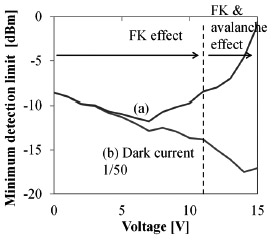Significant L-Band Responsivity Improvement of Germanium Waveguide Photodiode by Franz-Keldysh Effect
The responsivity of germanium photodiode (GePD) for L-band (1565 – 1625 nm) decreases because of a decrease in the absorption coefficient of germanium around 1580-nm wavelength [1]. Hence, increase in the responsivity is required to apply a GePD as a photodetector for the L-band. Under a high-bias condition, the Franz-Keldysh (FK) effect might increase responsivity in the L-band. An increase of absorption coefficients under high bias voltage was recently observed in the band around 1580 nm [2]. Moreover, the avalanche effect also might increase responsivity in the L-band. The avalanche multiplication gain should be observed in the L-band because it does not depend on wavelength. In this study, we investigate the responsivity of a GePD driven with a high bias field to give rise to the FK and avalanche effects in the L-band. And we separate the contribution of each to the responsivity by calculating the influences of them.
We employed a waveguide coupled GePD to measure the responsivity in the
L-band under high bias voltage. The width, length, and thickness of the
Ge mesa are 10, 50, and 1 μm, respectively. The dark currents are about
117 nA and 111 μA at 2- and 15-V bias voltage. Figure 1 shows the responsivity
of the GePD for various bias voltages. The responsivity at 15 V bias reaches
over 1.14 A/W in the whole L-band. At bias voltage above 11 V, it increases
with bias voltage owing to the avalanche effect. In order to exclude the
influence of avalanche effect, the responsivity was normalized by the avalanche
multiplication factor (Mav) as shown in Fig. 2. In the band from 1550 to 1640 nm, the responsivity increases for all bias voltages. This behavior agrees well with the calculation result of FK effect described as solid line in Fig. 2. Thus, we conclude that the high responsivity in the L-band of GePD is derived from the FK and the avalanche effect. Figure 3 (a) shows the minimum detection limit of GePD at a wavelength of 1640 nm. The minimum detection limits decrease because of the responsivity increase due to the FK effect as the bias voltage increases. However, they increase rapidly at bias voltage of over 11 V. This is because huge noise from dark current due to avalanche multiplication. Figure 3 (b) shows the minimum detection limit when the dark current is suppressed to 1/50 of the experimental values in this work. The avalanche effect is effective in this case. Thus, Optimized reduction of dark current and control of the bias field applied to Ge are necessary to obtain effective multiplication due to both effects.
To the best of our knowledge, this study is the first observation of responsivity increase in GePD for the L-band. And it opens up a possibility of GePD as L-band detector.
- [1]
- C. T. DeRose, et al., Opt. Express 19 (2011) 24897.
- [2]
- T. Y. Liow, et al., in Proc. OFC, no OM3K. 2 (2013).
 |
 |

|
|
|
|